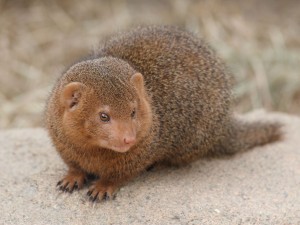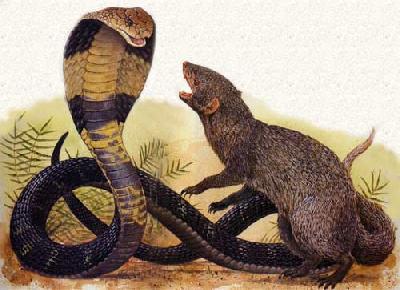Common Gray Mongoose
The Common Gray Mongoose also known as the Indian Gray Mongoose is a small species of predator that live in India, Sri Lanka and nearby territories. These capable hunters are often bred in captivity to help get rid of rats, mice and other unwelcome guests.
This Mongoose has a fur coloured gray with black, and a long, bushy tail. The animal’s body reaches a length of 43 cm, with a 39 cm long tail. The thick fur allows the Gray Mongoose to blend in and become practically invisible in bushes and grassy areas, and it also protects from snake bites, as the venom fangs are often not long enough to actually reach the skin and pierce it. It’s a widely known fact that Mongooses are more resistant to snake venom than other animals, thus making them very powerful enemies to the legless reptiles.
Common Gray Mongooses are very agile animals, their movement consists of many small jumps. It can climb trees, dig caves or even walk backwards. They are solitary animals that feed mostly during the day, spending the night in an abandoned cave or one dug by the animal itself. Their favourite areas are grasslands with rare or no growth at all.
Relying on the sharp vision and excellent hearing, the Mongoose can easily find and track down prey. Its diet consists mostly of rats, mice, other small mammals, as well as scorpions, bugs and bird eggs. These animals are known for their relentlessness – in fight, the Mongoose will always outlast the opponent, and chase runners with a matching endurance. Although the Mongoose feeds mostly on small animals, it may sometimes choose to attack a cobra. Having a much higher fortitude, the mammal exhausts the snake and finishes the fight with a quick bite to the head.
Although the Gray Mongoose is widespread in its inhabited areas, not much is known about the mating habits. As many solitary animals, they meet others of their kin only during the mating period, possibly spending some time together after copulation. Pregnancy lasts for about 60 days, and 2-4 pups are given birth in a well secluded shelter. They are poorly developed and blind for the first few weeks. After a bit more than a month, they start accompanying their mother in hunting and quickly learn to catch food by themselves. They begin independent lives no later than half a year after being born, and reach sexual maturity at the age of 2, while the life expectancy is up to 10 years.
An interesting fact about the Mongoose is that they can distinguish quite many colours, while most mammals are mostly colour-blind. This probably helps the animal hunt and find prey. Feeding mostly on creatures that are unwelcome by humans, the Mongooses have attained a positive reputation. They also hold no value in regards of usable fur or meat, thus humans pose no threat to this species and their number remains strong in all populated territories.




wounderfull picturs